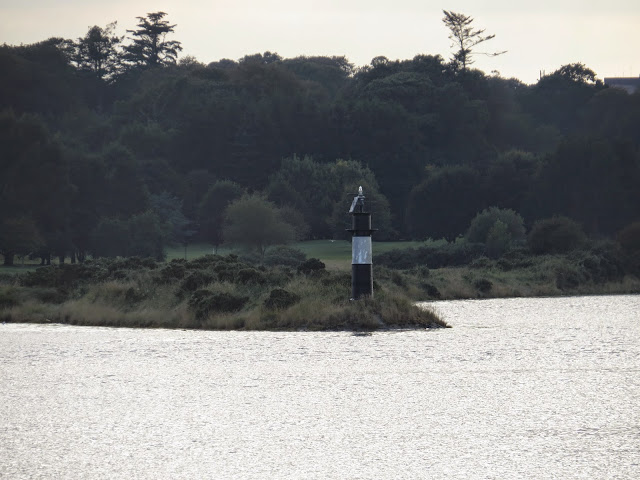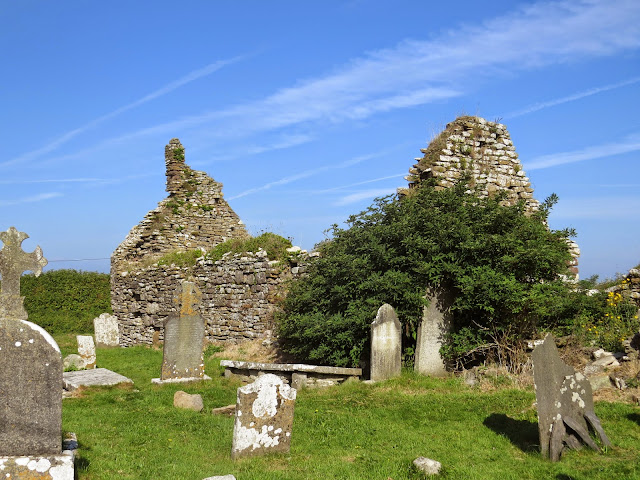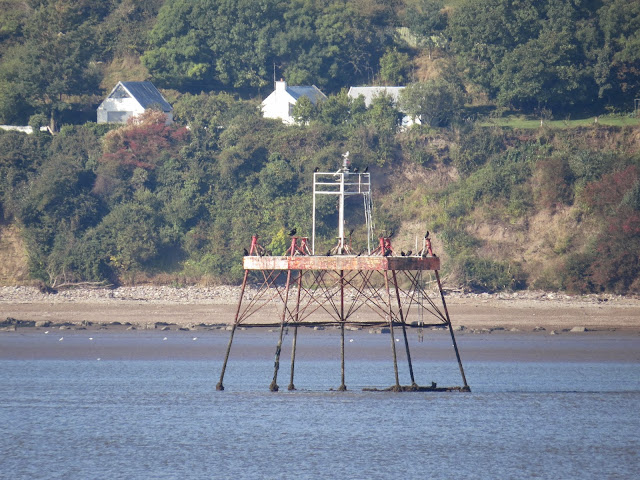A blog about Irish Lighthouses past and present and other selected maritime beacons and buoys of interest. If anybody has any corrections or additional info on any post, please use the comment section or the email address on the right.
Monday, October 20, 2014
Dunmore Harbour Coastwatch tower
As the Lighthouse Directory points out, Marinas has included this Coast Watch tower overlooking Dunmore East harbour on the list of their lighthouses. It isn't actually a lighthouse though. (This view is a poor shot from the landward side - Marinas' photos, as always, are much better)
There is a similar coast watch tower adjoining Hook Head lighthouse on the far side of the river.(sixth photo down)
Dunmore East
One of my favourite spots on the coast is Dunmore East, lovely thatched cottages, a lovely cliff top park, nice beach with picnic area and on a sunny day it has views to die for. We were here back in 2008, when I got close-up and personal with the lighthouses, so contented myself this time with views looking down at the harbour.
One of my favourite Irish lighthouses (I do tend to say that about a lot of them!) this one has a rather unique design - in Ireland anyway. It was built in 1825 by the great Alexander Nimmo, a Scottish engineer who built numerous harbours and bridges, though, as far as we are certain, this is his only lighthouse. There is a school of thought that he says he was also responsible for building the beacons at Tramore Bay too, (here) but there is some dispute over this.
I am told the lighthouse resembles a fluted Doric column. I'll go along with that.
Note the new pierhead light and also Hook Head across the estuary in the background
Killea Village
The little hamlet of Killea lies about a mile inland from Dunmore East, on high ground overlooking the coast. An ancient topographical dictionary of the area, dated 1837, says the village contained "Round Tower (stump of) supposed to have been an ancient lighthouse"
Well, I looked but couldn't see the ruins of a round tower, either in the current church grounds, or in the graveyard, with the ruined square tower opposite it. And I can find no further clues to its existence. I suspect it was once the old church, rather than a lighthouse.
River Barrow and River Suir lights
A selection of lights along the Rivers Barrow and Suir, between Ballyhack and Waterford. Once upon a time, Waterford was the destination of the mail boat from England and the Barrow and Suir weren't the easiest rivers to navigate,
This one is actually described as 'the little lighthouse' in a route of a walk of the area. In Cheekpoint, go down the road next to the store. At the bottom turn left and follow the road around. It degenerates into a path and thence to the river's edge. The lighthouse is about 50m southwards
Don't know if this is a beacon or a daymark. Looks like its on the westerly entrance to Kings Channel, which branches from the Suir to form Little Island, on which sits a swanky hotel and golf course. This view from the little car ferry that visits the island from Ballynakill.
This one is actually described as 'the little lighthouse' in a route of a walk of the area. In Cheekpoint, go down the road next to the store. At the bottom turn left and follow the road around. It degenerates into a path and thence to the river's edge. The lighthouse is about 50m southwards
Don't know if this is a beacon or a daymark. Looks like its on the westerly entrance to Kings Channel, which branches from the Suir to form Little Island, on which sits a swanky hotel and golf course. This view from the little car ferry that visits the island from Ballynakill.
These are all around Cheekpoint where the Barrow and Suir merge.
Took me ages to find this one. Visible from the 13th green at Faithlegg, looking just a little upriver. Actually on Faithlegg grounds. Looks nothing like the photo on Trabas.
Located on the most easterly point of Little Island, again taken from the 13th green at Faithlegg.
Ballyhack, co Wexford, where the car ferry crosses from Passage East in Waterford
Cheekpoint again
Duncannon Rear Light
We passed by Duncannon Rear Light on the road from Duncannon to Ballyhack and took these photos. Not much different from when were last there in 2008, when we took our photos from the exact same spot. This is the original 1817 Roches Point Light, deemed too small for that location, and transported to Duncannon in 1838.
A paper dated from the 1860s indicates that there was actually a third fixed light at Duncannon at that time, located on top of Black Hill. I can't even find Black Hill on any maps!
Duncannon Fort
The last time we were in Duncannon, we approached it from the north, paid our entrance fee into the fort and got some good close-up photos of the light. This was back in 2008. We had thought that the fort represented about all there was to see. So we were very surprised approaching Duncannon from the south to find a pretty little village and a glorious sandy beach which we walked and were able to get a new perspective on the light.
Apparently a light has shone from this point since the eighteenth century, helping ships up the treacherous waters of the River Barrow. The river is full of banks and shoals and bars and, by lining up the fort light with the Rear Light, about a mile further north, the right approach up the river can be made.
Saturday, September 13, 2014
The First Light
Here's an interesting question (or perhaps it isn't) Where was Ireland's first lighthouse?
Well, according to tradition, St. Dubhan, a Welsh monk, and contemporary of the much more famous Patrick, came to this lonely peninsula and established a monastery here in 452ad (about tea-time, as Monty Python would say) Here he established a lighted beacon for ships to warn them of the treacherous coastline hereabouts, a beacon that was tended for 700 years until the Tower was built in the early 13th Century.
But where was it, this beacon? It was probably a chauffer on top of a mound of stones. Adjoining Hook Lighthouse itself is an old wall and a small plaque on a wall saying 'Site of Monks' Chapel' To my eyes the wall in the top picture looks younger than 5th century but I'm no expert. If they had the chauffer right on the point, then it would probably have been around the site of the present tower.
Of course, they could have had it about a mile further north, where the ruins of the original monastery still stand, surrounded by a small graveyard. To be honest, I wouldn't build a monastery and then have to maintain a beacon a mile away but hey, those ancient monks were quare fellers altogether.
Anyhow, to cut to the chase, Ireland's first lighthouse lay between the ruins of the monastery and the tip of Hook Point. Can't narrow it down further than that, unless anybody else has further information.
Hook Head Lighthouse
We'd visited Hook about ten years previously, in our pre-digital camera days, but had somehow come away with very little in the way of photographic evidence. We decided to right that particular wrong this time! The last time, we did the tour, so we decided against it as we had a lot of stuff planned.
If the Fastnet Light is the most iconic of the Irish lighthouses, then Hook Head is the grand-daddy of them all. The blurb reads that it is the oldest operational lighthouse in the world, though I'm not so sure about that. Okay, the original tower was built in the early 13th Century but it has been built and rebuilt many times since then and it wasn't operational for all those years either.
But it is a beauty of a lighthouse. The original tower was built by the Normans to guide ships up the River Suir to the town of Ross. The nearby monks had been installed as custodians of the light, which was a coal fire burning on the tower's top. With the dissolution of the monasteries in the 17th century, the light flared no more but it was one of six tendered for by Robert Reading in 1665.
Reading was keen to take the money from passing ships but not so interested in maintaining the light. The keepers were obliged to supplement their income through various nefarious activities and the light sometimes suffered as a result. The coal fire was only replaced in 1791.
Originally this lighthouse had three red bands instead of two black ones. I always have the impression that this is a rather dumpy tower, not slim and elegant like some. At 152 feet, it is tall enough, but it must have the largest girth of all Irish lights (says he with not a shred of evidence to back this up)
The Watchtower (presumably not what Dylan and Hendrix had in mind)
 |
Somewhere here, between the tower and the sea, there was the foghorn (according to the map) |
 |
Buoy at Hook |
 |
Another buoy at Hook |
 |
| Lightkeepers Cottages (now Visitors Centre) |
Passage Point, co. Waterford
A few days down in Waterford and boy, were we blessed with the weather. After a rubbish August, we got endless September sunshine. Best country in the world when the sun shines!
We decided to take the Passage East to Ballyhack ferry, joining Waterford to Wexford, and visit the lighthouse at Hook Head. On the way, we stopped off at Arthurstown to view this screwpile lighthouse in the middle of the Suir. I thought it was the only Leinster lighthouse I hadn't got, but seeing as it's joined to the Waterford side of the river by a sandbank, presumably it's a Munster lighthouse instead.
The Lighthouse Directory, God bless it, mentions the light being mounted on a brick column, as evidenced from the picture below, but there was no sign of the brick on our visit.
Wednesday, August 20, 2014
The Baily, Howth
The last time I photographed the Baily was on a trip by ferry to Holyhead and the weather didn't help me to get a good view
This time, my intrepid brother-in-law Aido managed to get a much better photo from the same ferry! The original light here was a brazier atop a cottage on the top of the hill (where the bungalow below the Summit car park now stands) The second light was a proper tower built on the same site but proved to be too high. Finally they got it right in 1814! This iconic light is actually difficult to photograph from the mainland, as the compound gate and the contour of the land conspire against you
Wednesday, July 30, 2014
Tuskar Rock
Tuskar Rock lighthouses is one of the great Irish lighthouses. The oldest Rock lighthouse on our coasts that is still in active service (South Rock off the coast of county Down is older but is long derelict) Tuskar has guarded the treacherous shoals and submerged rocks off the south east coast of Ireland since 1815. The area itself is where the Atlantic Ocean sweeps up the Irish Sea and can be subject to ferocious seas, such as the one that swept away the workmen's huts when the light was under construction, killing ten of them instantly. The remaining fourteen clung grimly to the rocks for 48 hours until rescued.
But how to photograph it? Well there are distant views from the coast - probably St Helens or Carne are your best bets, though you'll need good magnification. I looked around for boat tours - as they do for the Fastmet or Rockabill, but the only company who do them appear to be Harbour Thrills, a Wexford based company. They mention the Tuskar in their introductory blurb but don't specifically go there on their regular trips. Presumably you need to arrange with the captain and bring the numbers yourself.
So I caught the Stena ferry day trip from Rosslare to Fishguard, hoping it would go close enough to get good views. I was quite disappointed with my recent photos of The Kish from the Dublin Holyhead ferry (very blurred and hazy) and was hoping the same wouldn't be the same here. Apprehensively I watched the Pembroke ferry ahead of us pass quite close and hoped we'd follow suit. Thankfully we did.
It must have been the morning sun though because the photos again were quite hazy. The sea was light grey, the sky was light grey and the lighthouse is white, so they didn't come out great. Fortunately on the return, the contrast appeared a bit sharper! Sun would have been nice but it only poked its head out of the blanket of cloud when we were practically docked.
The light was first exhibited on 4th June 1815 and in foggy weather a bell was tolled every half minute. The tower was and still is painted white. The two keepers committed the ultimate lighthouse sin in 1821 when they failed to light the optic one night. With bad luck (or possibly good luck, whichever way you look it) the King of England happened to be sailing past and complained to the lighthouse board that the light wasn't showing. A subsequent investigation showed that the two men on duty had promised to guard a consignment of smuggled brandy for a local boatman and had helped themselves too liberally to their charge! Both men were downgraded as a result!
Tuskar was the third lighthouse on the coast to the converted to electric, the previous two were Donaghadee in 1934 and Chain Tower (Larne) in 1935. It was the first Irish off-shore lighthouse to be electrified. During wartime small rocks like Tuskar were very vulnerable to drifting mines which had parted from their moorings. One of these mines exploded when it struck the rock on 2nd December 1941 injuring two assistant keepers, W. J. Cahill and P. Scanlan. Both were brought ashore by the Rosslare lifeboat but unfortunately Patrick Scanlan died in hospital the next day.
Subscribe to:
Posts (Atom)



















































